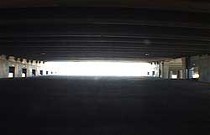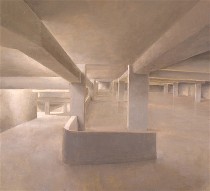 Parking lots have become the icons in our modern world for the empty, dehumanized plazas, the mazes, the oppressive architecture, the video surveillance approach to safety, and the isolation and tyranny of the automobile culture.
Parking lots have become the icons in our modern world for the empty, dehumanized plazas, the mazes, the oppressive architecture, the video surveillance approach to safety, and the isolation and tyranny of the automobile culture.
This is the space that video artist Peter Rose has filmed in his new video, “Odysseus in Ithaca” (still images top right and below right) showing at the Philadelphia Art Museum until Feb. 9 (read museum’s excellent info here).
 As Roberta pointed out to me the other day, Rose is in good company in using the parking lot (in this case a lot in Conshohocken, filmed over the weekend when no one uses it). She was thinking about Mark Shetabi’s juicy parking lot paintings (left, Shetabi’s “The Desert: Parking Garage”) and Thomas Demand’s “Tunnel,” an animated video of his reconstruction of the place where Lady Diana died (see post) .
As Roberta pointed out to me the other day, Rose is in good company in using the parking lot (in this case a lot in Conshohocken, filmed over the weekend when no one uses it). She was thinking about Mark Shetabi’s juicy parking lot paintings (left, Shetabi’s “The Desert: Parking Garage”) and Thomas Demand’s “Tunnel,” an animated video of his reconstruction of the place where Lady Diana died (see post) .
These are familiar spaces, which we enter almost daily. Alas, they are not places for people. They are places for cars, machines. They are ominous spaces of hard concrete and low ceilings and pitched floors in which we never feel at home and where we often feel lost. I want to add Nadia Hironaka’s video wanderings through abandoned structures to this list of uncomfortable places.
 What I liked about Rose’s piece, besides its classical references was its formal visual poetry, in which the concrete beams twirl, sometimes interlocking like cogs between the three panels, sometimes leaping from panel to panel, as the slightly tilted floor gets sucked into the past. We haven’t come far, architecturally, from the post-and-lintel Parthenon. Lots of columns. Heavy overheads.
What I liked about Rose’s piece, besides its classical references was its formal visual poetry, in which the concrete beams twirl, sometimes interlocking like cogs between the three panels, sometimes leaping from panel to panel, as the slightly tilted floor gets sucked into the past. We haven’t come far, architecturally, from the post-and-lintel Parthenon. Lots of columns. Heavy overheads.
I was looking at “Odysseus” with my friend Bay, who works at the museum, and she admired the beautiful pinks and yellows of the lit-up concrete, which created a kind of Minimalist landscape (and here I don’t think Doug Witmer can fault me for misuse of the M word).
But ultimately, it’s not the beauty of the structure that impresses but the beauty of the intercutting, the use of the structure’s features to structure a visual rhythm with light and dark and a spiraling search for safety and escape into the light.
This piece has none of the theatrical wizardry of Rose’s last piece, “Pneumenonal,” at the Fabric Workshop (see post), with its confusion of real scrims and video scrims and its how-does-he-do-it/what’s-really-real punch.
“Odysseus” is far more buttoned down and painterly and art-historical and properly two-dimensional.
But its rich references to life as we know it and our cultural history and architecture made it hold my interest and my eye. It’s worth a visit.









